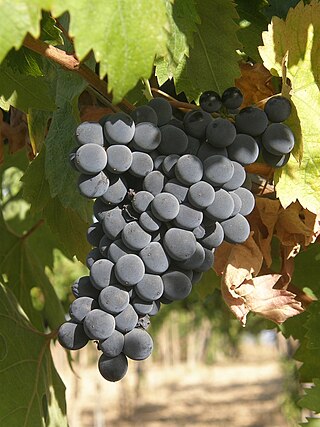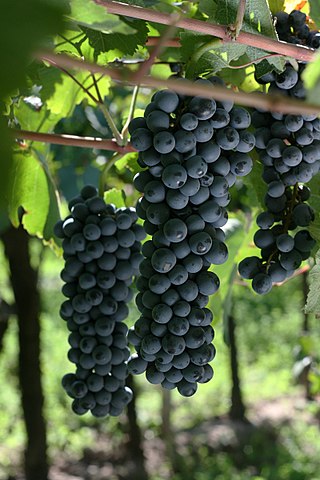
Merlot is a dark blue–colored wine grape variety that is used as both a blending grape and for varietal wines. The name Merlot is thought to be a diminutive of merle, the French name for the blackbird, probably a reference to the color of the grape. Its softness and "fleshiness," combined with its earlier ripening, make Merlot a popular grape for blending with the sterner, later-ripening Cabernet Sauvignon, which tends to be higher in tannin.

Barbera is a red Italian wine grape variety that, as of 2000, was the third most-planted red grape variety in Italy. It produces good yields and is known for deep color, full body, low tannins and high levels of acidity.

Folle blanche, also known as Picpoule, Gros Plant, and Enrageat blanc, is a wine grape variety from southwest France. It was the traditional grape variety in Cognac and Armagnac production until the 20th century. Folle blanche is an offspring of Gouais blanc, with the other parent so far unidentified.

The Zweigelt, also known as Rotburger, is an Austrian hybrid grape variety created in 1922 by Friedrich Zweigelt (1888–1964), who later became Director of the Federal Institute and Experimental Station of Viticulture, Fruit Production and Horticulture (1938–1945). Zweigelt is a crossing between the St. Laurent and Blaufränkisch grape varieties.

The Muscat family of grapes includes over 200 grape varieties belonging to the Vitis vinifera species that have been used in wine production and as raisin and table grapes around the globe for many centuries. Their colors range from white, to yellow, to pink to near black. Muscat grapes and wines almost always have a pronounced floral aroma. The breadth and number of varieties of Muscat suggest that it is perhaps the oldest domesticated grape variety, and there are theories that most families within the Vitis vinifera grape variety are descended from the Muscat variety.

Trollinger, Schiava, or Vernatsch, is a red German/Italian wine grape variety that was likely first originally cultivated in the wine regions of South Tyrol and Trentino, but today is almost exclusively cultivated on steep, sunny locations in the Württemberg wine region of Baden-Württemberg. It is primarily known under the synonyms Trollinger in Germany, Vernatsch in South Tyrol and Schiava in other Italian regions. As a table grape the variety is sometimes known as Black Hamburg, which is commonly confused with the similar synonym for Black Muscat—a variety that is actually a cross of Trollinger and Muscat of Alexandria.

Montepulciano is a red Italian wine grape variety that is most noted for being the primary grape behind the DOCG wines Colline Teramane Montepulciano d'Abruzzo and Offida Rosso; and the DOC wines Montepulciano d'Abruzzo, Rosso Conero, and Rosso Piceno Superiore.
Vernaccia di Oristano is a white Italian wine grape variety grown on the island of Sardinia which makes a wide range of wine styles for the Denominazione di origine controllata (DOC) of Vernaccia di Oristano based in the province of Oristano. This includes both dry and sweet wines as well as fortified "sherry-like" wines aged in a solera. The grape has a long history on the island of Sardinia with Sardinians claiming that consuming ample quantities of wine produced from the grape as being responsible for low instances of malaria on the island.
Uva Rara is a red Italian wine grape variety that is grown in the Piedmont and Lombardy wine regions of northern Italy. The grape is a permitted blending variety along with Nebbiolo in the Denominazione di Origine Controllata e Garantita (DOCG) wines of Ghemme. In the Denominazione di Origine Controllata (DOC) wine region of Oltrepò Pavese the grape is often blended with Barbera and Croatina. While Uva Rara's name means "rare grape" in Italian, the variety is actually widely planted with 608 hectares of the vine recorded in Italy in 2000.

Incrocio Manzoni or Manzoni grapes is a family of grape varieties named after Professor Luigi Manzoni (1888-1968) of Italy's oldest school of oenology located in Conegliano, in the Veneto region. Manzoni created the new grape varieties by selecting, crossing and grafting vines from various vineyards during the 1920s and 1930s. The family includes both white and red grape varieties. Although most Manzonis are grown in northeastern Italy, they are mainly grown in the Piave area of Province of Treviso and are only now starting to be sold commercially in Europe and the United States.
Trepat is a red Catalan wine grape variety that is grown primarily in the Conca de Barberà and Costers del Segre Denominación de Origen (DO)s of Catalonia. Ampelographers believe that the grape is likely indigenous to Northeastern Iberian Peninsula. Today there are approximately 1,500 hectares of the variety, used mostly for light rosé.
Albarossa is a red Italian wine grape variety that was created in the Veneto wine region in 1938 by grape breeder Giovanni Dalmasso at the Istituto Sperimentale per la Viticoltura in Conegliano. Dalmasso originally thought he created the grape from a crossing of Nebbiolo and Barbera but DNA profiling in 2009 confirmed that the "Nebbiolo" vine used wasn't Nebbiolo at all but rather a very old French wine grape variety from the Ardèche, Chatus. The confusion stemmed from a synonym of Chatus, Nebbiolo di Dronero.

Douce noir is a red Savoyard wine grape variety that has historically been grown in the Savoy region, but today is more widely planted in Argentina.
Barbera bianca is a white Italian wine grape variety that is grown in the Piedmont wine region of northwest Italy. Despite being named Barbera bianca, the grape is not a color mutation of the red Piedmontese wine grape Barbera that is the third most widely planted grape variety in Italy. In fact, DNA analysis conducted in the early 21st century shows no genetic relationship at all between the two grape varieties.
Caíño blanco or Cainho branco is a white Spanish and Portuguese wine grape variety that is grown in northwest Spain and northern Portugal in a stretch of area between Vinho Verde and the Denominación de Origen (DO) of Rías Baixas. The grape is often confused for Albariño and in Vinho Verde it is sometimes known under the name Alvarinhão. While DNA profiling conducted in the early 21st century has shown that the two grapes are distinct varieties, the evidence has suggested that Caíño blanco maybe an offspring of Albariño from a natural crossing with the red Portuguese wine grape Azal tinto.
Vernaccia is the name of several or synonym of Italian wine grape varieties including:
Avanà is a red Italian wine grape variety that is grown in the Piedmont wine region of northwest Italy. Historically, the grape has also been grown in the Dauphiné and Savoie wine region of eastern France where it was known as Hibou noir and in the Valais region of Switzerland. The grape is most often used as a blending variety in the Denominazione di origine controllata (DOC) zones of Pinerolese, with Barbera, Persan, Freisa and Neretta Cuneese, and Valsusa, with Barbera, Dolcetto, Neretta Cuneese and other local red Piemontese varieties.
Barbera del Sannio is a red Italian wine grape variety that is grown in the Campania region of southern Italy. Despite the similarities in name and appearance, the grape has no close genetic relationship with the Piedmont wine grapes Barbera or Barbera bianca or the Sardinian wine grape Barbera Sarda and is, instead, more closely related to the Campanian varieties Casavecchia and Catalanesca and the Apulian grape Nero di Troia.
Barbera Sarda is a red Italian wine grape variety that is grown on the island of Sardinia where it often used to add acidity to blends. Despite the similarities in their names, there is no known close genetic relationship between the Sardinian Barbera and the notable Piedmontese wine grape variety Barbera. Nor does there seem to be any close relationship with other grapes names Barbera, such as Barbera bianca and Barbera del Sannio.
Bianchetta Trevigiana is a white Italian wine grape variety that is grown in the Trentino-Alto Adige/Südtirol and Veneto wine regions of northeast Italy. Here the grape is rarely used a varietal but, instead, is a permitted blending grape adding acidity to the wines of several Denominazione di Origine Controllata (DOC) zones including the sparkling wine Prosecco and has also been used for vermouth production. The name Trevigiana is derived from the province of Treviso where the grape is believed to have originated from.








